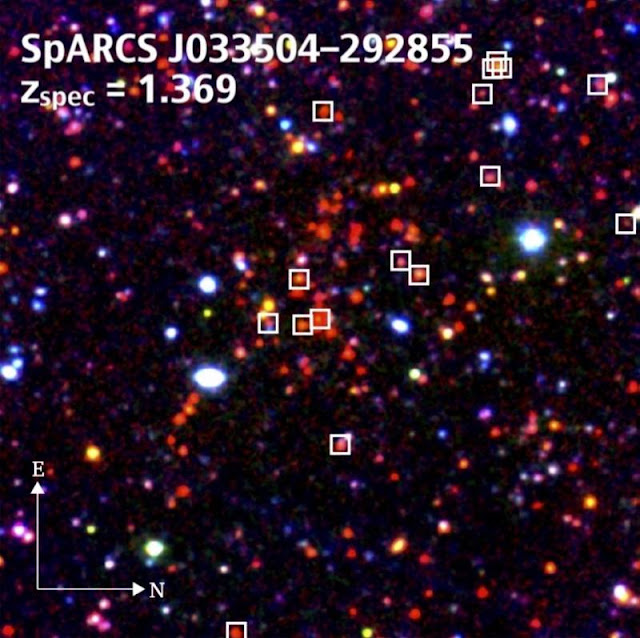Massive galaxy cluster MACS J0416 seen in X-rays (blue), visible light (red, green, and blue), and radio light (pink).
Credit: NASA/CXC/SAO/G.Ogrean/STScI/NRAO/AUI/NSF
Credit: NASA/CXC/SAO/G.Ogrean/STScI/NRAO/AUI/NSF
Color images of the central regions of z > 1.35 SpARCS clusters.
Cluster members are marked with white squares.
Credit: Nantais, et al.
Cluster members are marked with white squares.
Credit: Nantais, et al.
MAUNAKEA, Hawaii — The international University of
California, Riverside-led SpARCS collaboration has discovered four of
the most distant clusters of galaxies ever found, as they appeared when
the Universe was only four billion years old. Clusters are rare regions
of the Universe consisting of hundreds of galaxies containing trillions
of stars, as well as hot gas and mysterious Dark Matter. Spectroscopic
observations from the W. M. Keck Observatory on Maunakea, Hawaii and the
Very Large Telescope in Chile confirmed the four candidates to be
massive clusters. This sample is now providing the best measurement yet
of when and how fast galaxy clusters stop forming stars in the early
Universe.
“We looked at how the properties of galaxies in these
clusters differed from galaxies found in more typical environments with
fewer close neighbors,” said lead author Julie Nantais, an assistant
professor at the Andres Bello University in Chile. “It has long been
known that when a galaxy falls into a cluster, interactions with other
cluster galaxies and with hot gas accelerate the shut off of its star
formation relative to that of a similar galaxy in the field, in a
process known as environmental quenching. The SpARCS team have
developed new techniques using Spitzer Space Telescope infrared
observations to identify hundreds of previously-undiscovered clusters of
galaxies in the distant Universe.”
As anticipated, the team did
indeed find that many more galaxies in the clusters had stopped forming
stars compared to galaxies of the same mass in the field. Gillian
Wilson, professor of physics and astronomy at UC Riverside, added,
“Fascinatingly, however, the study found that the percentage of galaxies
which had stopped forming stars in those young, distant clusters, was
much lower than the percentage found in much older, nearby clusters.
While it had been fully expected that the percentage of cluster galaxies
which had stopped forming stars would increase as the Universe aged,
this latest work quantifies the effect.”
The paper concludes that
about 30 percent of the galaxies which would normally be forming stars
have been quenched in the distant clusters, compared to the much higher
value of about 50 percent found in nearby clusters.
Several
possible physical processes could be responsible for causing
environmental quenching. For example, the hot, harsh cluster environment
might prevent the galaxy from continuing to accrete cold gas and form
new stars; a process astronomers have named “starvation”. Alternatively,
the quenching could be caused by interactions with other galaxies in
the cluster. These galaxies might “harass” (undergo frequent, high
speed, gravitationally-disturbing encounters), tidally strip (pull
material from a smaller galaxy to a larger one) or merge (two or more
galaxies joining together) with the first galaxy to stop its star
formation.
While the current study does not answer the question of
which process is primarily responsible, it is nonetheless hugely
important because it provides the most accurate measurement yet of how
much environmental quenching has occurred in the early Universe.
Moreover, the study provides an all-important early-Universe benchmark
by which to judge upcoming predictions from competing computational
numerical simulations which make different assumptions about the
relative importance of the many different environmental quenching
processes which have been suggested, and the timescales upon which they
operate.
The W. M. Keck Observatory findings were obtained as the
result of a collaboration amongst UC faculty members Gillian Wilson
(UCR) and Michael Cooper (UCI), and graduate students Andrew DeGroot
(UCR) and Ryan Foltz (UCR). Other authors involved in the study are
Remco van der Burg (Université Paris Diderot), Chris Lidman (Australian
Astronomical Observatory), Ricardo Demarco (WUniversidad de Concepción,
Chile), Allison Noble (University of Toronto, Canada) and Adam Muzzin
(University of Cambridge).
The W. M. Keck Observatory operates the
largest, most scientifically productive telescopes on Earth. The two,
10-meter optical/infrared telescopes near the summit of Maunakea on the
Island of Hawaii feature a suite of advanced instruments including
imagers, multi-object spectrographs, high-resolution spectrographs,
integral-field spectrographs and world-leading laser guide star adaptive
optics systems.
MOSFIRE (Multi-Object Spectrograph for Infrared
Exploration) is a highly-efficient instrument that can take images or up
to 46 simultaneous spectra. Using a sensitive state-of-the-art detector
and electronics system, MOSFIRE obtains observations fainter than any
other near infrared spectrograph. MOSFIRE is an excellent tool for
studying complex star or galaxy fields, including distant galaxies in
the early Universe, as well as star clusters in our own Galaxy. MOSFIRE
was made possible by funding provided by the National Science Foundation
and astronomy benefactors Gordon and Betty Moore.
Keck
Observatory is a private 501(c) 3 non-profit organization and a
scientific partnership of the California Institute of Technology, the
University of California and NASA.
Media Contact:
Steve Jefferson
W. M. Keck Observatory
(808) 881-3827
sjefferson@keck.hawaii.edu
Source: W.M. Keck Observatory

